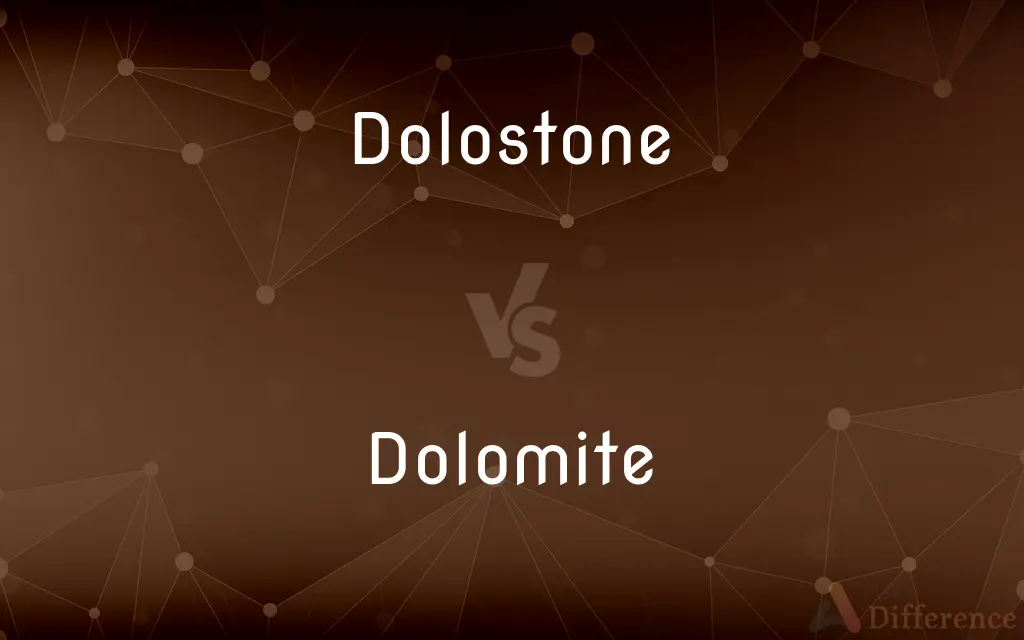Dolostone vs. Dolomite — What's the Difference?
By Tayyaba Rehman & Fiza Rafique — Updated on May 5, 2024
Dolostone is a sedimentary rock primarily composed of the mineral dolomite, whereas dolomite refers specifically to the mineral itself, consisting mainly of calcium magnesium carbonate.

Difference Between Dolostone and Dolomite
Table of Contents
ADVERTISEMENT
Key Differences
Dolostone, also known as dolomite rock, is a sedimentary carbonate rock that contains a high percentage of the mineral dolomite. On the other hand, dolomite is a mineral composed of calcium magnesium carbonate, scientifically known as CaMg(CO3)2. While dolostone encompasses a rock type, dolomite defines the specific mineral composition within that rock.
Dolostone is typically formed through the diagenetic alteration of limestone where magnesium-rich groundwater converts calcite into dolomite. Whereas, dolomite as a mineral can precipitate directly from seawater or freshwater under certain environmental conditions, contributing to the formation of dolostone but also existing independently in other geological contexts.
The properties of dolostone as a rock include its greater hardness and slightly different weathering characteristics compared to pure limestone, due to its dolomite content. Conversely, dolomite the mineral has a specific crystal structure that can be characterized by its trigonal-rhombohedral crystal form, which influences the physical properties of the rock it composes.
Geologically, dolostone is significant in stratigraphy and paleoenvironmental reconstructions, helping geologists understand past environmental conditions. On the other hand, dolomite mineral plays a role not only as a rock-forming mineral but also in the geochemical cycling of carbon and magnesium.
When used commercially, dolostone is often quarried for use as aggregate, crushed stone, or as a soil treatment agent. In contrast, dolomite mineral can be used in the production of refractory bricks used in furnaces and kilns due to its high heat resistance.
ADVERTISEMENT
Comparison Chart
Composition
Rock composed mainly of dolomite mineral
Mineral primarily calcium magnesium carbonate
Formation
From limestone through magnesium-rich fluids
Direct precipitation from seawater or freshwater
Crystal Structure
Not applicable as a rock
Trigonal-rhombohedral
Use in Geology
Studied for environmental reconstructions
Analyzed for mineralogical and geochemical properties
Commercial Use
Building material, soil conditioner
Refractory material, ornamental stone
Compare with Definitions
Dolostone
Carbonate rock.
Dolostone layers often contain fossils which are well-preserved.
Dolomite
Component of dolostone.
Dolomite constitutes over 90% of some dolostone samples.
Dolostone
Soil conditioner.
Crushed dolostone is used to raise the pH of acidic soils.
Dolomite
Mineral.
Dolomite crystals can be found lining the cavity of certain rocks.
Dolostone
Building material.
Dolostone is quarried for use in construction due to its durability.
Dolomite
Calcium magnesium carbonate.
The chemical formula for dolomite is CaMg(CO3)2.
Dolostone
Diagenetically altered limestone.
The limestone gradually transitioned into dolostone due to groundwater influences.
Dolomite
Refractory material.
Dolomite is processed into bricks that can withstand very high temperatures.
Dolostone
Sedimentary rock.
The cliff was composed predominantly of dolostone, identifiable by its buff color.
Dolomite
Geochemical importance.
Dolomite participates in the geochemical cycling of carbonates.
Dolostone
(geology) A sedimentary carbonate rock that contains a high percentage of the mineral dolomite.
Dolomite
A white or light-colored mineral, essentially CaMg(CO3)2, used in fertilizer, as a furnace refractory, and as a construction and ceramic material.
Dolostone
A stone or rock entirely composed of the mineral dolomite.
Dolomite
A magnesia-rich sedimentary rock resembling limestone.
Dolomite
(mineral) An evaporite consisting of a mixed calcium and magnesium carbonate, with the chemical formula CaMg(CO3)2; it also exists as the rock dolostone.
Dolomite
A mineral consisting of the carbonate of lime and magnesia in varying proportions. It occurs in distinct crystals, and in extensive beds as a compact limestone, often crystalline granular, either white or clouded. It includes much of the common white marble. Also called bitter spar.
Dolomite
A kind of sedimentary rock resembling limestone but consisting almost entirely of the mineral dolomite
Dolomite
A light colored mineral consisting of calcium magnesium carbonate; a source of magnesium; used as a ceramic and as fertilizer
Common Curiosities
How is dolostone formed?
Dolostone forms through the replacement of parts of limestone with the mineral dolomite, often due to magnesium-rich fluids.
What is the main difference between dolostone and dolomite?
Dolostone is a rock primarily composed of the mineral dolomite, while dolomite is a specific mineral itself.
Why is dolostone important in geological studies?
Dolostone helps geologists interpret past environmental conditions and can indicate mineral presence and reservoir quality.
Can dolomite be found outside of dolostone?
Yes, dolomite can precipitate directly from solutions in nature and can be found in other geological settings aside from dolostone.
How do dolomite and dolostone contribute to carbon cycling?
Both play roles in sequestering carbon within the earth's crust, dolomite through geochemical processes and dolostone by containing the mineral.
What are the uses of dolomite?
Dolomite is used in the manufacturing of refractory bricks, as an ornamental stone, and in the chemical industry.
What distinguishes dolomite's crystal structure?
Dolomite has a trigonal-rhombohedral crystal structure which can be recognized under microscopic examination.
How does the chemical composition of dolomite affect its properties?
The presence of magnesium makes it more resistant to weathering and gives it a higher melting point.
What kind of textures are found in dolostone?
Dolostone can exhibit a variety of textures, from fine to coarse grained, depending on its formation conditions.
Is dolostone harder than limestone?
Yes, generally, dolostone tends to be harder and more durable than limestone due to its dolomite content.
Are dolostone and dolomite visually distinguishable?
Dolostone is distinguishable as a rock, while dolomite, being a mineral, might require specific tests or microscopic analysis to identify.
How is dolomite mined or extracted?
Dolomite is typically extracted through mining operations similar to other minerals and rocks.
Where is dolostone commonly found?
Dolostone deposits are common in sedimentary basins and can be significant components of mountain ranges.
What role does dolomite play in soil treatments?
Dolomite adjusts soil pH and adds essential nutrients like magnesium and calcium.
Can dolostone be used in aquatic environments?
Yes, dolostone is often used in aquariums to help buffer water pH and add mineral content.
Share Your Discovery

Previous Comparison
Bulgogi vs. Bibimbap
Next Comparison
Croissant vs. BagelAuthor Spotlight
Written by
Tayyaba RehmanTayyaba Rehman is a distinguished writer, currently serving as a primary contributor to askdifference.com. As a researcher in semantics and etymology, Tayyaba's passion for the complexity of languages and their distinctions has found a perfect home on the platform. Tayyaba delves into the intricacies of language, distinguishing between commonly confused words and phrases, thereby providing clarity for readers worldwide.
Co-written by
Fiza RafiqueFiza Rafique is a skilled content writer at AskDifference.com, where she meticulously refines and enhances written pieces. Drawing from her vast editorial expertise, Fiza ensures clarity, accuracy, and precision in every article. Passionate about language, she continually seeks to elevate the quality of content for readers worldwide.
















































